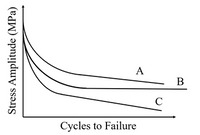
Elements Of Electromagnetics
7th Edition
ISBN: 9780190698614
Author: Sadiku, Matthew N. O.
Publisher: Oxford University Press
expand_more
expand_more
format_list_bulleted
Concept explainers
Question
Use the fatigue curves below to answer the following questions.:
Which curve represents a sample subjected to fatigue at the lowest mean tensile stress? (Select One)
Group of answer choices
Curve A
Curve B
Curve C

Transcribed Image Text:A
B
C
Cycles to Failure
Stress Amplitude (MPa)
Expert Solution
This question has been solved!
Explore an expertly crafted, step-by-step solution for a thorough understanding of key concepts.
Step by stepSolved in 2 steps

Knowledge Booster
Learn more about
Need a deep-dive on the concept behind this application? Look no further. Learn more about this topic, mechanical-engineering and related others by exploring similar questions and additional content below.Similar questions
- Draw a typical stress vs strain tensile test curve for the following material and label the axis. A typical brittle material subjected to a tensile stress that has been applied to the material till the sample breaks. 1- label the axis and draw the curve for a brittle material. 2- indicate the maximum strength of the material. 3- show on the portion of the curve where young's modulus can be calculated.arrow_forwardNeed help on this Qarrow_forward1. For the stress-strain curve shown below, please estimate the properties indicated. (a) Fracture Strain Please do your work on a separate sheet of paper, and put your answers in the boxes on the right. Be sure to include the proper symbol and units. Stress Strain 70 60 50 Stress (ksi) 240 30 20 10 70 0 0.000 60 50 Stress (ksi) 40 20 10 KULL 0 0.000 0.010 0.050 0.100 Strain (in/in) Stress Strain 0.020 0.030 Strain (in/in) 0.040 0.150 0.050 (b) Ultimate Tensile Stress (c) Fracture Stress (d) Proportional Limit (e) Elastic Modulus (1) Yield Stress (g) Tensile Toughness (Modulus of Toughness) (h) Modulus of Resiliencearrow_forward
- You have been given the following test sample data following mechanical testing of 15 test pieces of Silicon Nitride. What is the Weibull modulus of this material? Would you advise the use of a similar material with a Weibull Modulus of 16.3 and a mean failure stress of 485 MPa, if you anticipate that the peak stress on the material could be 430 MPa? Sample 1 2 3 4 5 6 7 8 9 10 11 12 13 14 15 Select one or more: O a. No O b. 18.6 O C. 13.4 O d. Yes O e. 15.7 f. 17.1 Failure Stress (MPa) 423 459 496 432 447 467 473 499 485 479 505 530 526 490 510 <arrow_forwardHow did temperature affect the toughness of the specimens?arrow_forwardThe answer is one of the options below please solve carefully and circle the correct option Please write clear .arrow_forward
- Question 5: Following is tabulated data that were gathered from a series of Charpy impact tests on a tempered 4140 steel alloy. Temperature (°C) 100 75 50 25 0 -25 -50 -65 -75 -85 -100 -125 -150 -175 Impact Energy (J) 89.3 88.6 87.6 85.4 82.9 78.9 73.1 66.0 59.3 47.9 34.3 29.3 27.1 25.0 (a) Plot the data as impact energy versus temperature. (you can use Excel or other software). (b) Determine a ductile-to-brittle transition temperature as that temperature corresponding to the average of the maximum and minimum impact energies. (c) Determine a ductile-to-brittle transition temperature as that temperature at which the impact energy is 70 J.arrow_forwardUse the fatigue curves below to answer the following questions.: Which curve(s) represent(s) a non-ferrous metal? (Select all that apply) Group of answer choices Curve B Curve A Curve Carrow_forward3. A cylindrical specimen of cold-worked copper has a ductility, %EL. If its cold-worked radius is d, what was its radius before deformation? Use %EL=25%; d = 10mm Ductility (%EL) 70 60 50 40 30 20 Brass 1040 Steel 10 Copper 0 0 10 110 20 30 40 50 60 70 Percent cold workarrow_forward
arrow_back_ios
arrow_forward_ios
Recommended textbooks for you
 Elements Of ElectromagneticsMechanical EngineeringISBN:9780190698614Author:Sadiku, Matthew N. O.Publisher:Oxford University Press
Elements Of ElectromagneticsMechanical EngineeringISBN:9780190698614Author:Sadiku, Matthew N. O.Publisher:Oxford University Press Mechanics of Materials (10th Edition)Mechanical EngineeringISBN:9780134319650Author:Russell C. HibbelerPublisher:PEARSON
Mechanics of Materials (10th Edition)Mechanical EngineeringISBN:9780134319650Author:Russell C. HibbelerPublisher:PEARSON Thermodynamics: An Engineering ApproachMechanical EngineeringISBN:9781259822674Author:Yunus A. Cengel Dr., Michael A. BolesPublisher:McGraw-Hill Education
Thermodynamics: An Engineering ApproachMechanical EngineeringISBN:9781259822674Author:Yunus A. Cengel Dr., Michael A. BolesPublisher:McGraw-Hill Education Control Systems EngineeringMechanical EngineeringISBN:9781118170519Author:Norman S. NisePublisher:WILEY
Control Systems EngineeringMechanical EngineeringISBN:9781118170519Author:Norman S. NisePublisher:WILEY Mechanics of Materials (MindTap Course List)Mechanical EngineeringISBN:9781337093347Author:Barry J. Goodno, James M. GerePublisher:Cengage Learning
Mechanics of Materials (MindTap Course List)Mechanical EngineeringISBN:9781337093347Author:Barry J. Goodno, James M. GerePublisher:Cengage Learning Engineering Mechanics: StaticsMechanical EngineeringISBN:9781118807330Author:James L. Meriam, L. G. Kraige, J. N. BoltonPublisher:WILEY
Engineering Mechanics: StaticsMechanical EngineeringISBN:9781118807330Author:James L. Meriam, L. G. Kraige, J. N. BoltonPublisher:WILEY

Elements Of Electromagnetics
Mechanical Engineering
ISBN:9780190698614
Author:Sadiku, Matthew N. O.
Publisher:Oxford University Press

Mechanics of Materials (10th Edition)
Mechanical Engineering
ISBN:9780134319650
Author:Russell C. Hibbeler
Publisher:PEARSON

Thermodynamics: An Engineering Approach
Mechanical Engineering
ISBN:9781259822674
Author:Yunus A. Cengel Dr., Michael A. Boles
Publisher:McGraw-Hill Education

Control Systems Engineering
Mechanical Engineering
ISBN:9781118170519
Author:Norman S. Nise
Publisher:WILEY

Mechanics of Materials (MindTap Course List)
Mechanical Engineering
ISBN:9781337093347
Author:Barry J. Goodno, James M. Gere
Publisher:Cengage Learning

Engineering Mechanics: Statics
Mechanical Engineering
ISBN:9781118807330
Author:James L. Meriam, L. G. Kraige, J. N. Bolton
Publisher:WILEY